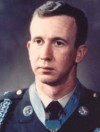Medal of Honor history: Patrick Brady and Don Jenkins

On this day in military history, two American soldiers earned the Medal of Honor – the nation’s highest decoration for valor. 44 years ago on January 6, 1968, Major Patrick Henry Brady (citation), commander of the 54th Medical Detachment, volunteered for a dangerous “dust off” mission near Chu Lai, Vietnam. Wounded soldiers were pinned down in enemy-held territory that was also reportedly blanketed with dense fog. Upon arrival, Brady descended through the dense fog and smoke to reach the two South Vietnamese soldiers. Despite the close proximity to enemy forces who were firing at the unarmed helicopter, Brady landed his aircraft and evacuated the men.
On his next mission, American troops were wounded and pinned down 50 meters from an enemy position. Two helicopters had been shot down and other attempts to rescue the troops were unsuccessful. Maj. Brady made four flights into the contested area and evacuated all of the wounded.
Next, Brady flew into another area surrounded by enemy forces. This time, his helicopter was badly damaged, but he was able to extract the wounded. Brady was called upon once more, this time to assist a platoon trapped in a minefield. Upon landing, a mine detonated near his aircraft, injuring two crewmembers and damaging the helicopter. Brady would return with yet another helicopter – his third of the day – and evacuate six more wounded soldiers.
“If you cared enough about the lives you were trying to save, you would find a way,” Brady stated in an interview at the Pritzker Military Library in 2007. That day, Brady rescued 51 seriously-wounded soldiers, many of whom would have died had it not been for his “unmatched skill and extraordinary courage.”
Over his two tours, Brady flew 2,000 missions and rescued 5,000 wounded soldiers. In Brady’s first tour, he was part of the only medevac company (five helicopters) in Vietnam. He retired as a Major General in 1993 after 34 years in the Army.

One year after Brady’s actions, helicopters inserted members of the 39th Infantry Regiment into the Kien Phong Province on a reconnaisance mission. After landing, Private First Class Don Jenkins (citation)and the men of his unit immediately began receiving heavy crossfire from North Vietnamese Army bunkers that encircled the landing zone.
Jenkins ran to an exposed area and opened fire on enemy soldiers gathering near log bunkers with his M-60. When his machine gun jammed, Jenkins grabbed another rifle and fired upon the enemy while a teammate attempted to repair the M-60. He repeatedly charged through open terrain to grab ammunition from fallen soldiers until he could no longer find any ammunition. Then Jenkins picked up two anti-tank weapons from another fallen soldier. Despite incoming enemy fire, he closed within 20 yards of the enemy bunkers and destroyed two of them.
Then the resourceful soldier picked up an M-79 grenade launcher and resumed his destruction until that weapon was exhausted as well. Meanwhile, an group of soldiers was pinned down just meters away from the enemy. Previous rescue attempts had resulted in one death and many injuries, but that news must not have phased Jenkins. Ignoring serious shrapnel wounds in his stomach and legs, Jenkins crawled forward 100 meters to the embattled position three times over the course of the night, each time bringing back a wounded comrade.
Following the battle, Jenkins was promoted to Staff Sergeant. Oddly enough however, Jenkins’ commanding officer had threatened to bust him down to Private the day prior to his heroic actions: Jenkins needed to be resuscitated due to drinking a poisoned bottle of wine.
Following his discharge, Jenkins returned to the coal mines of Kentucky, and received notification that he was to be awarded the Medal in 1971.